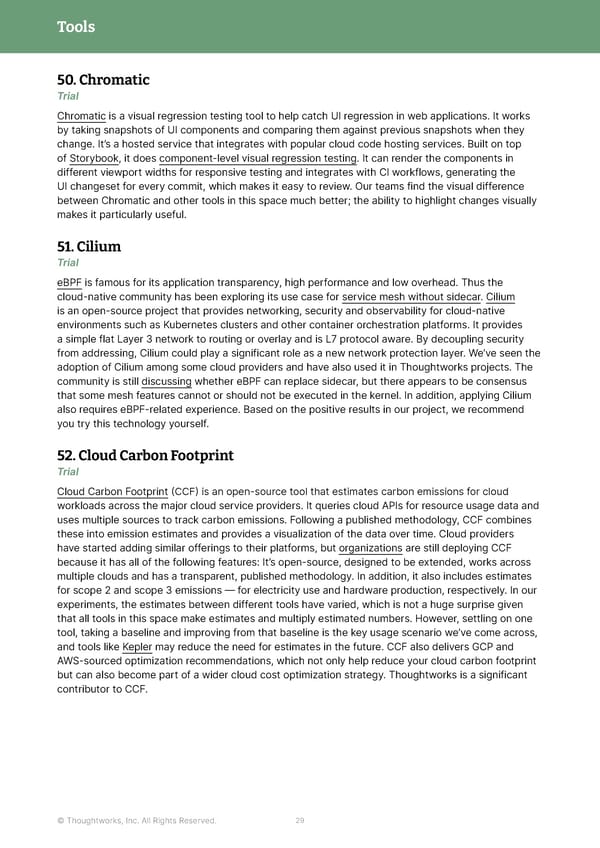Tools 50. Chromatic Trial Chromatic is a visual regression testing tool to help catch UI regression in web applications. It works by taking snapshots of UI components and comparing them against previous snapshots when they change. It’s a hosted service that integrates with popular cloud code hosting services. Built on top of Storybook, it does component-level visual regression testing. It can render the components in different viewport widths for responsive testing and integrates with CI workflows, generating the UI changeset for every commit, which makes it easy to review. Our teams find the visual difference between Chromatic and other tools in this space much better; the ability to highlight changes visually makes it particularly useful. 51. Cilium Trial eBPF is famous for its application transparency, high performance and low overhead. T hus the cloud-native community has been exploring its use case for service mesh without sidecar. Cilium is an open-source project that provides networking, security and observability for cloud-native environments such as Kubernetes clusters and other container orchestration platforms. It provides a simple flat Layer 3 network to routing or overlay and is L7 protocol aware. By decoupling security from addressing, Cilium could play a significant role as a new network protection layer. We’ve seen the adoption of Cilium among some cloud providers and have also used it in Thoughtworks projects. The community is still discussing whether eBPF can replace sidecar, but there appears to be consensus that some mesh features cannot or should not be executed in the kernel. In addition, applying Cilium also requires eBPF-related experience. Based on the positive results in our project, we recommend you try this technology yourself. 52. Cloud Carbon Footprint Trial Cloud Carbon Footprint (CCF) is an open-source tool that estimates carbon emissions for cloud workloads across the major cloud service providers. It queries cloud APIs for resource usage data and uses multiple sources to track carbon emissions. Following a published methodology, CCF combines these into emission estimates and provides a visualization of the data over time. Cloud providers have started adding similar offerings to their platforms, but organizations are still deploying CCF because it has all of the following features: It’s open-source, designed to be extended, works across multiple clouds and has a transparent, published methodology. In addition, it also includes estimates for scope 2 and scope 3 emissions — for electricity use and hardware production, respectively. In our experiments, the estimates between different tools have varied, which is not a huge surprise given that all tools in this space make estimates and multiply estimated numbers. However, settling on one tool, taking a baseline and improving from that baseline is the key usage scenario we’ve come across, and tools like Kepler may reduce the need for estimates in the future. CCF also delivers GCP and AWS-sourced optimization recommendations, which not only help reduce your cloud carbon footprint but can also become part of a wider cloud cost optimization strategy. Thoughtworks is a significant contributor to CCF. © Thoughtworks, Inc. All Rights Reserved. 29
 Thoughtworks Technology Radar Page 28 Page 30
Thoughtworks Technology Radar Page 28 Page 30